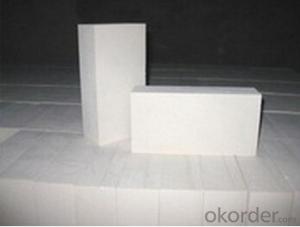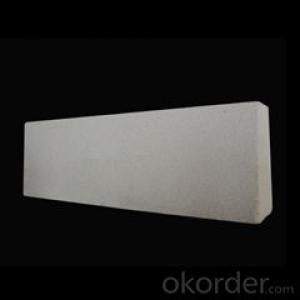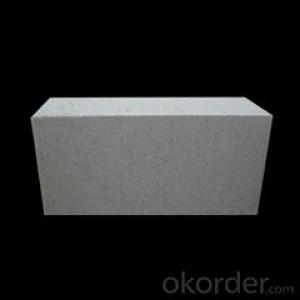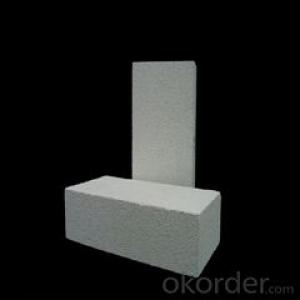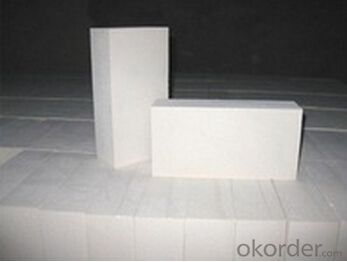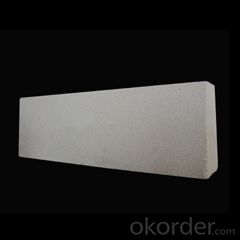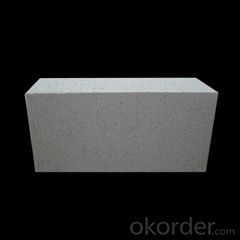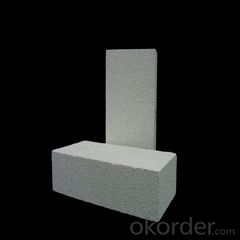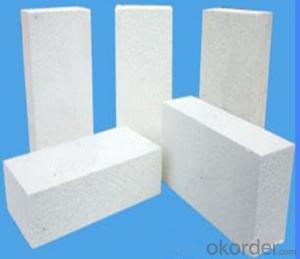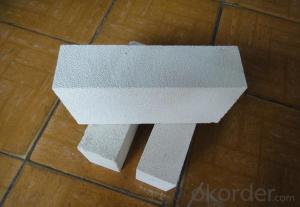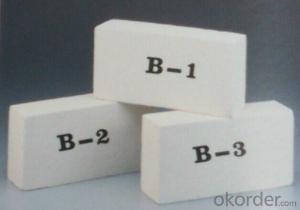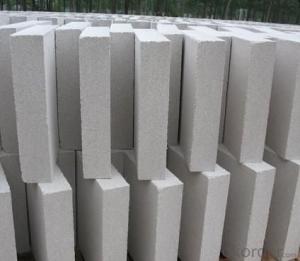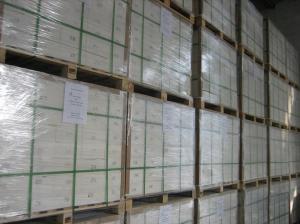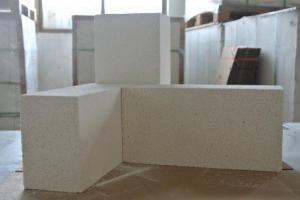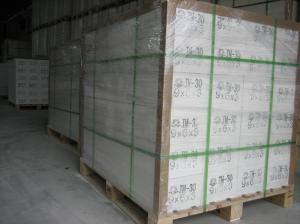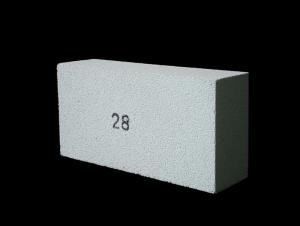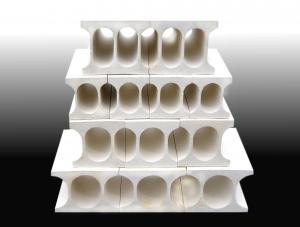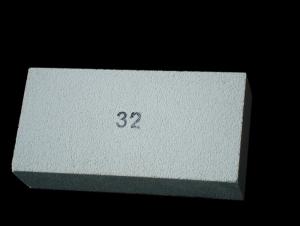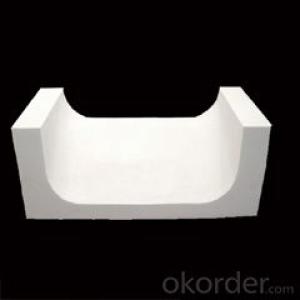Refractory mullite insulating refractory brick JM 93
- Loading Port:
- Shanghai
- Payment Terms:
- TT OR LC
- Min Order Qty:
- 5000 kg
- Supply Capability:
- 10000 kg/month
OKorder Service Pledge
OKorder Financial Service
You Might Also Like
Refractory mullite insulating refractory brick JM 23
Okorder series heat insulation brick
Okorder series thermal insulation brick is an effective, energy saving, low carbon, environmental protection advanced, according to the ASTM standard manufacturing products. Okorder series products are best Li Ning and insulation in all types of industrial furnaces in the metallurgical field, aluminum, petrochemical, electric power and glass ceramic materials. They can be used as part of the working layer of thermal insulation or non - melting. Products have been widely used in the following furnace, achieved satisfactory results.
Application of heat preservation brick
Metallurgical Industry: blast furnace, hot blast furnace, heating furnace, etc..
Petrochemical Industry: ethylene cracking furnace, hydrogen production furnace, primary reformer, heating furnace, etc..
Ceramic industry: roller kiln, kiln, etc..
Glass industry: glass furnace regenerator, etc.
Carbon industry: carbon furnace, etc..
Aluminum electrolysis industry: aluminum reduction cell, etc.
Other industries: tunnel kiln, shuttle kiln, etc..
Advantages of heat insulation brick
Low thermal conductivity: more porosity will bring good thermal insulation effect, energy saving.
High crushing strength: high crushing strength, volume stability.
Low heat storage: small heat storage to absorb more heat, energy-saving effect is obvious.
Gao Chundu: iron, alkali metal impurity content is low.
The precise size: Brick size processing precision, special shape cutting and grinding, accelerate the brickwork.
Insulating brick picture
Common problem solutions
1. What products do you have?
We have all kinds of refractory bricks, refractory casting materials, mortar, cement, ceramic fiber products, etc..
Or you can browse our products to choose what you need.
2. How to control product quality?
With strict quality control system throughout the material selection and production process, we have the quality of refractory materials and ceramic fiber products to meet customer requirements.
From the selection of raw materials, the quality of our control to start. The quality certificate of the raw material is required, each batch of the products are to be tested in the use of the forward line. In the production process, the quality control by the workers, and then each piece of classification, and through the quality supervision and inspection.
3. Can you give me a brief introduction to the application of your product?
My company is mainly engaged in refractories in the steel, cement, glass, ceramics, petrochemical, electric power and other industries.
4. What information do you need if I need you?
In order to select the right products, we will provide us with information, such as the United States, technical data, order quantity, product application, etc..
If you have any questions, please contact us.


- Q: Are insulating fire bricks suitable for use in coke ovens?
- Yes, insulating fire bricks are suitable for use in coke ovens. These bricks are designed to withstand high temperatures and provide excellent insulation properties, making them ideal for use in coke ovens where extreme heat is generated during the coking process. They help to maintain the desired temperature inside the oven and prevent heat loss, resulting in improved energy efficiency and reduced fuel consumption. Additionally, insulating fire bricks have good resistance to chemical reactions and thermal shock, which further enhances their suitability for use in coke ovens.
- Q: What are the dimensions of insulating fire bricks?
- Insulating fire bricks are usually available in different dimensions, which vary depending on the manufacturer and specific usage. However, the most frequently used dimensions for insulating fire bricks are 9 inches by 4.5 inches by 2.5 inches (or 230mm by 114mm by 64mm). These dimensions are widely accepted and commonly employed in the industry. It is worth mentioning that distinct projects might necessitate diverse dimensions, and it is advisable to consult the manufacturer or supplier to determine the most suitable dimensions for your requirements.
- Q: Can insulating fire bricks be used in the construction of metal smelting molds?
- Yes, insulating fire bricks can be used in the construction of metal smelting molds. Insulating fire bricks are designed to withstand high temperatures, making them suitable for use in smelting processes where extreme heat is required. These bricks have excellent thermal insulation properties, which help to retain the heat and minimize heat loss during the smelting process. This is important for maintaining a consistent temperature within the mold, ensuring efficient and successful metal smelting. Additionally, insulating fire bricks are lightweight and easy to handle, making them a practical choice for constructing molds. Overall, insulating fire bricks are a reliable and effective option for constructing metal smelting molds.
- Q: Can insulating fire bricks be used in the construction of crucibles?
- Insulating fire bricks can indeed be utilized for constructing crucibles. These bricks are crafted from lightweight materials like clay and silica, boasting remarkable thermal insulation properties. Consequently, they are highly suitable for scenarios that require the preservation of high temperatures and minimal heat loss, such as crucible construction. Crucibles, extensively employed in industries like metallurgy and chemistry, serve the purpose of containing and melting materials at exceedingly elevated temperatures. By incorporating insulating fire bricks into crucible construction, heat loss is curtailed, energy efficiency is enhanced, and a more consistent temperature is maintained within the crucible, ultimately resulting in improved overall performance. Furthermore, the lightweight nature of these fire bricks facilitates easier handling and installation, further augmenting their appropriateness for crucible construction.
- Q: Can insulating fire bricks be used in the construction of combustion chambers?
- Yes, insulating fire bricks can be used in the construction of combustion chambers. Insulating fire bricks are made from lightweight, porous materials that have excellent thermal insulation properties. This makes them ideal for use in high-temperature applications, such as combustion chambers, where the insulation helps to contain and control the heat generated during the combustion process. Insulating fire bricks have a high resistance to heat transfer, which allows them to effectively retain heat within the combustion chamber. This helps to improve the overall efficiency of the combustion process by reducing heat loss to the surrounding environment. Additionally, the insulating properties of these bricks can help to prevent overheating of the outer walls of the combustion chamber, reducing the risk of structural damage. Furthermore, insulating fire bricks are designed to withstand high temperatures, making them highly durable and resilient. This is crucial in combustion chambers where intense heat and fluctuating temperatures are common. Their ability to withstand thermal shock and thermal cycling makes them a reliable choice for this application. In summary, insulating fire bricks are an excellent choice for the construction of combustion chambers due to their thermal insulation properties, ability to retain heat, and resistance to high temperatures. They contribute to the overall efficiency and safety of the combustion process, making them a valuable component in combustion chamber construction.
- Q: Can insulating fire bricks be used in contact with molten metal?
- Yes, insulating fire bricks can be used in contact with molten metal. Insulating fire bricks are specially designed to withstand high temperatures and are commonly used in industrial applications where they come into contact with molten metal. These bricks have a high resistance to thermal shock and are able to withstand the intense heat generated by molten metal. Additionally, insulating fire bricks have low thermal conductivity, which helps to minimize heat loss and improve energy efficiency. However, it is important to ensure that the specific type of insulating fire brick being used is suitable for the particular type of molten metal and the temperature range it will be exposed to, as different metals have different melting points and may require more specialized refractory materials.
- Q: Can insulating fire bricks be used in the construction of thermal storage units?
- Yes, insulating fire bricks can be used in the construction of thermal storage units. These bricks are designed to withstand high temperatures and provide excellent insulation, making them suitable for thermal storage applications where heat retention is crucial.
- Q: Can insulating fire bricks be used in the construction of autoclaves?
- Yes, insulating fire bricks can be used in the construction of autoclaves. Autoclaves require materials that can withstand high temperatures and pressures, and insulating fire bricks are designed to have excellent thermal resistance and insulation properties. These bricks are made from refractory materials like alumina, silica, and other additives that allow them to withstand extreme temperatures and thermal shocks. They are also lightweight and have low thermal conductivity, which helps to minimize heat loss and improve energy efficiency in autoclaves. Additionally, insulating fire bricks have good load-bearing capacity, making them suitable for the structural components of autoclaves. Overall, the use of insulating fire bricks in the construction of autoclaves helps to ensure the safety and efficiency of the equipment.
- Q: What bricks are thermal insulation bricks?
- First, replace the aluminum plate, honeycomb board, curtain wall and other common decorative materials, multi-functional integration, a construction can solve the two requirements of thermal insulation decoration, smooth, smooth and beautiful, decorative strong.Two, high strength, good rigidity, light quality, seismic resistance, wind resistance, creep resistance, superior performance, reduce building load, more economical and durable.Three, fire retardant, heat preservation, energy saving, sound insulation, heat insulation, crack resistance, waterproof, according to the 65% building energy conservation requirements for construction design.Four. The installation of the finished product is simple, the process is simplified, the construction period is shortened, and the quality is easy to control.Five, no aluminum, steel, keel support, embedded in the installation, reduce the insulation board and the gap between the wall. Increased safety system.Six, no radiation, green environmental protection, can be widely used in various types of public buildings and family interior decoration.
- Q: Do insulating fire bricks require any maintenance?
- Insulating fire bricks, also known as refractory bricks, have been designed to endure high temperatures and offer exceptional insulation properties. One notable advantage of these bricks is their minimal maintenance requirements. These bricks are crafted from specialized materials that exhibit high heat resistance and are not easily prone to cracking or breaking, thereby reducing the need for frequent repairs or replacements. Nevertheless, similar to other materials, insulating fire bricks may accumulate dust or debris over time. To preserve their effectiveness and extend their lifespan, it is recommended to regularly clean them by employing a soft brush or vacuum cleaner to eliminate any loose particles. Additionally, it is crucial to periodically inspect the bricks for any signs of damage, such as cracks or erosion. Promptly addressing any identified issues is vital to prevent further deterioration. In summary, although insulating fire bricks do not demand extensive upkeep, regular cleaning and inspection are essential to ensure their optimal performance and longevity.
Send your message to us
Refractory mullite insulating refractory brick JM 93
- Loading Port:
- Shanghai
- Payment Terms:
- TT OR LC
- Min Order Qty:
- 5000 kg
- Supply Capability:
- 10000 kg/month
OKorder Service Pledge
OKorder Financial Service
Similar products
Hot products
Hot Searches
Related keywords
